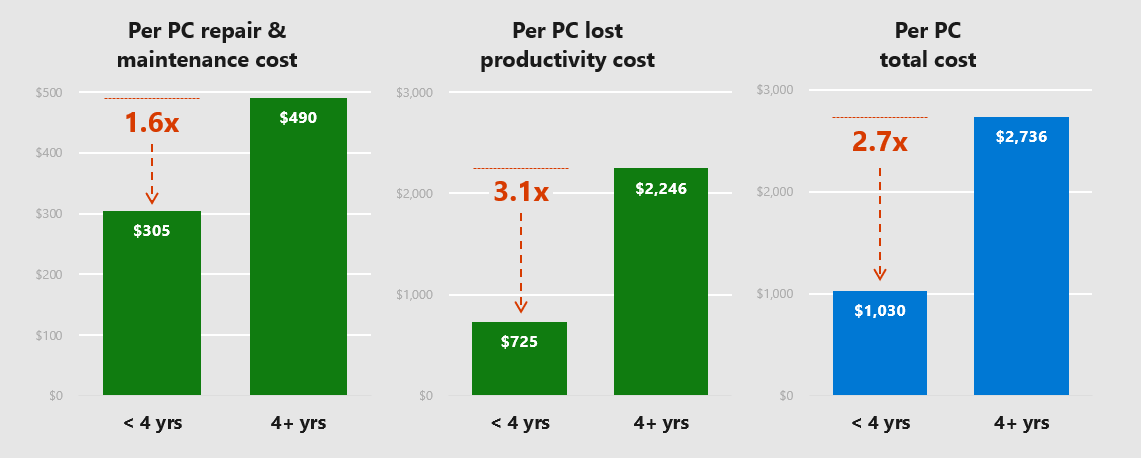Increasing profitability, improving workforce productivity and reducing operational costs are among the top five business issues for SMBs in the Asia/Pacific region. Cost is sometimes a tricky item to nail down as too often SMBs focus on short term costs. In most cases this approach is absolutely valid but it can lead to situations that cost them more. The choice between maintaining older PCs and replacing them with newer PCs is one such area. Techaisle, conducted a Pan-Asia survey of 2156 SMBs in five countries to understand the comparative differences in costs of maintaining older & newer PCs and associated quantifiable productivity lost and the impact of newer PCs. Findings from the survey, commissioned by Microsoft & Intel, and driving Microsoft’s “Make the Shift Campaign” in the Pan-Asian region, uncovers that the cost of upkeeping a PC older than four years can be used to purchase at least two new Modern PCs.
The study reveals that the cost of owning a 4 year or older PC by an SMB is US$2,736 which is 2.7 times the cost for a PC that is less than 4 years old. The study also revealed that an average of 112 hours is lost due to downtime of an older PC, a number that is 3.1X of newer PCs. This is a “stealth” cost that drains cash flow and adds to the operating cost of an SMB which they can hardly afford. Cost implications vary for SMBs of different sizes.

Maintaining older PCs negatively affects operating costs and diminishes employee productivity
70 percent of SMBs in Pan-Asia have PCs that are 4 years or older. 85 percent of SMBs with older PCs plan to replace but only 24 percent of older PCs may get replaced. These SMBs should re-evaluate their decision given the higher cost of maintaining older PCs which has a larger cumulative effect on the budget than purchasing newer PCs with modern technology.
When improving employee productivity is among the top business priorities of SMBs it is natural to assume that the businesses explore all options to achieve their priorities. However, in the daily grind of work sometimes cost reduction solutions staring in their face get overlooked unless someone demonstrates it to them. One such important opportunity is replacing older PCs with new PCs.
SMBs reported that they frequently experience application/system performance, malware attacks and connectivity related issues with PCs that are 4 years or older. All of these contribute to significant diminishing of employee productivity and satisfaction and unbeknownst to many SMBs these issues are chipping away at their cash flows and productive work hours.
Newer PCs positively impact productivity, reduce operating cost & provide better security
SMBs using newer PCs have experienced several positive impacts; top four are easy manageability, reduced costs, improved efficiency and improved productivity. In fact, 62 percent of SMBs reported improved employee productivity and 63 percent mentioned that newer PCs provide their employees with better cloud & mobility experiences.
Improved performance directly leads to improved productivity and efficiency. Along with better manageability and reduced overall maintenance expenses, newer PCs directly impact the bottom-line of SMBs by reducing operating costs.
Security, specifically related to cloud and mobility, is among the top three IT priorities for SMBs in Pan-Asia and data protection is the third top IT challenge. Effective IT security solutions contribute to organizational success and profitability because technology is important to business success & profitability and security is important to the value of technology. Survey revealed that as high as 67% of SMBs had experienced security & data theft breaches in the last 1 year. The frequency of attacks on older PCs was twice as high as newer PCs.
SMBs have an opportunity to improve their overall operations with modern devices. For those who have already made the move to newer PCs, study revealed that:
- 69% felt that they were better able to secure and protect their business data on newer PCs
- 65% agreed that it has helped reduce overall maintenance costs
- 63% saw improved efficiencies due to new experiences powered by cloud and mobility solutions
- 62% agreed that a newer PC has made their staff more productive
Financial Impact to SMBs
More than 42% of PCs used in SMBs are still on older versions of Windows today, according to the study. Upgrading to a Windows 10 modern device will offer experiences that are more familiar, safe, secure, and productive. MBs running Windows 7 devices within the organization should seek to make the shift before End of Support in January 2020.
59 percent of SMBs have either moved away from a PC replacement policy or are keeping their PCs in use longer than in previous years. 41 percent of SMBs cited fear of application compatibility and 27 percent mentioned lack of budget as a key reason for not replacing older PCs in spite of frequent issues and lost productivity. SMBs consider both direct and indirect costs resulting from PC downtime, that is, both the “visible” and “hidden” costs. Replacing, rather than repairing and upgrading will reduce cost of operations and free up budgets. An SMB with fifteen older PCs is losing an average of US$41,044 per year inclusive of repair, upgrade and lost productivity costs. These SMBs would be better served by buying newer PCs - the cost to own 15 older PCs is more than the purchase price of 15-20 newer PCs.